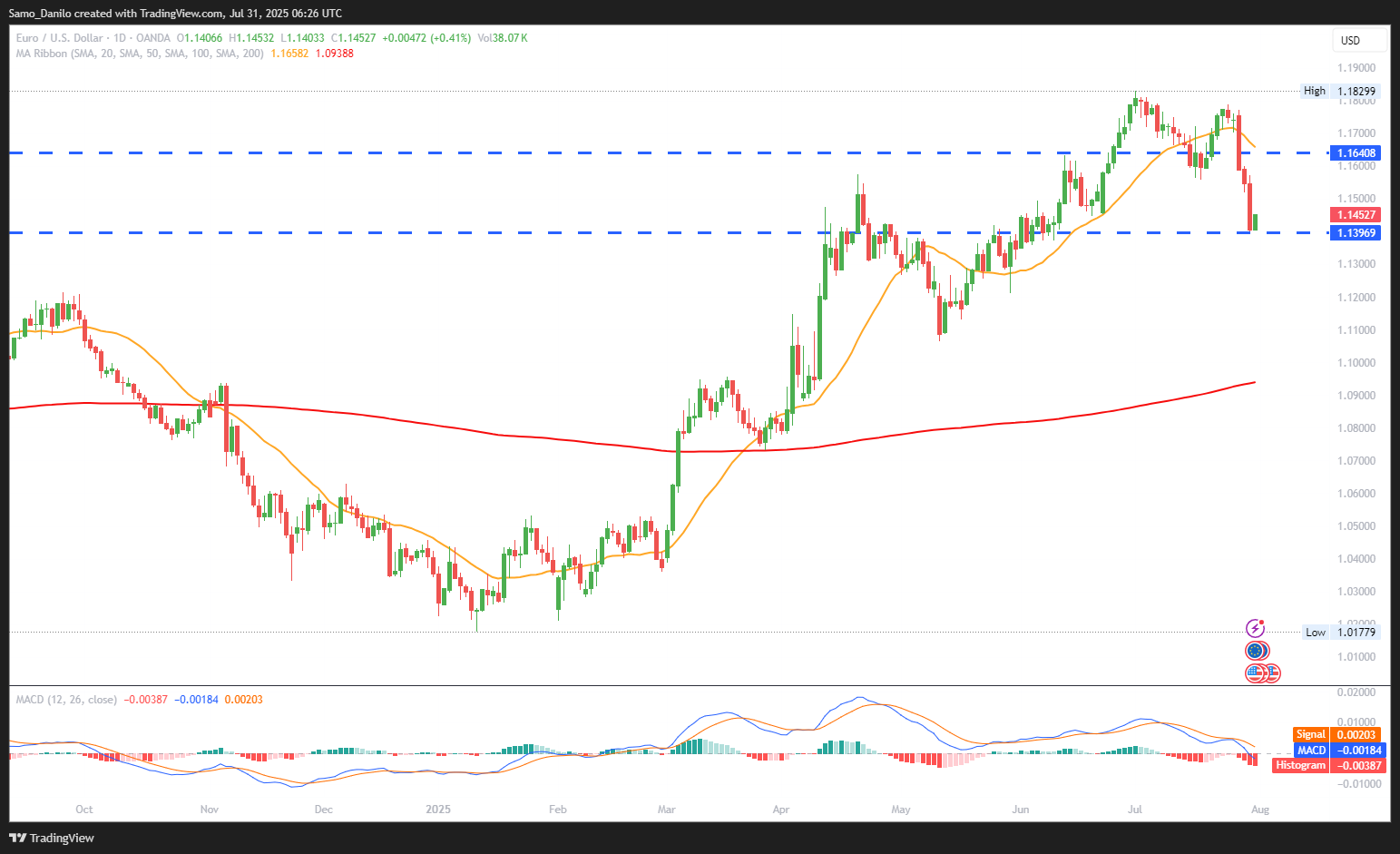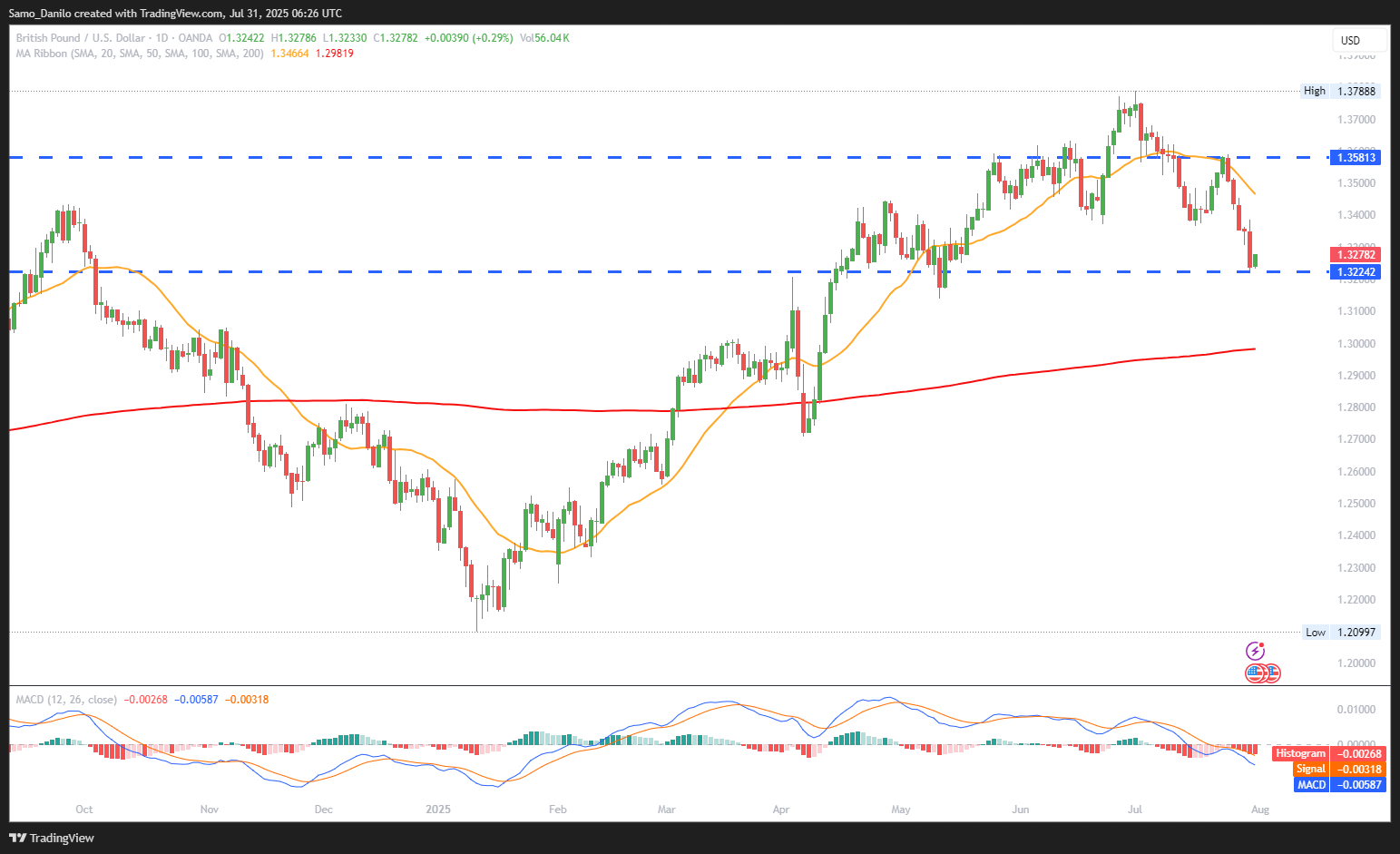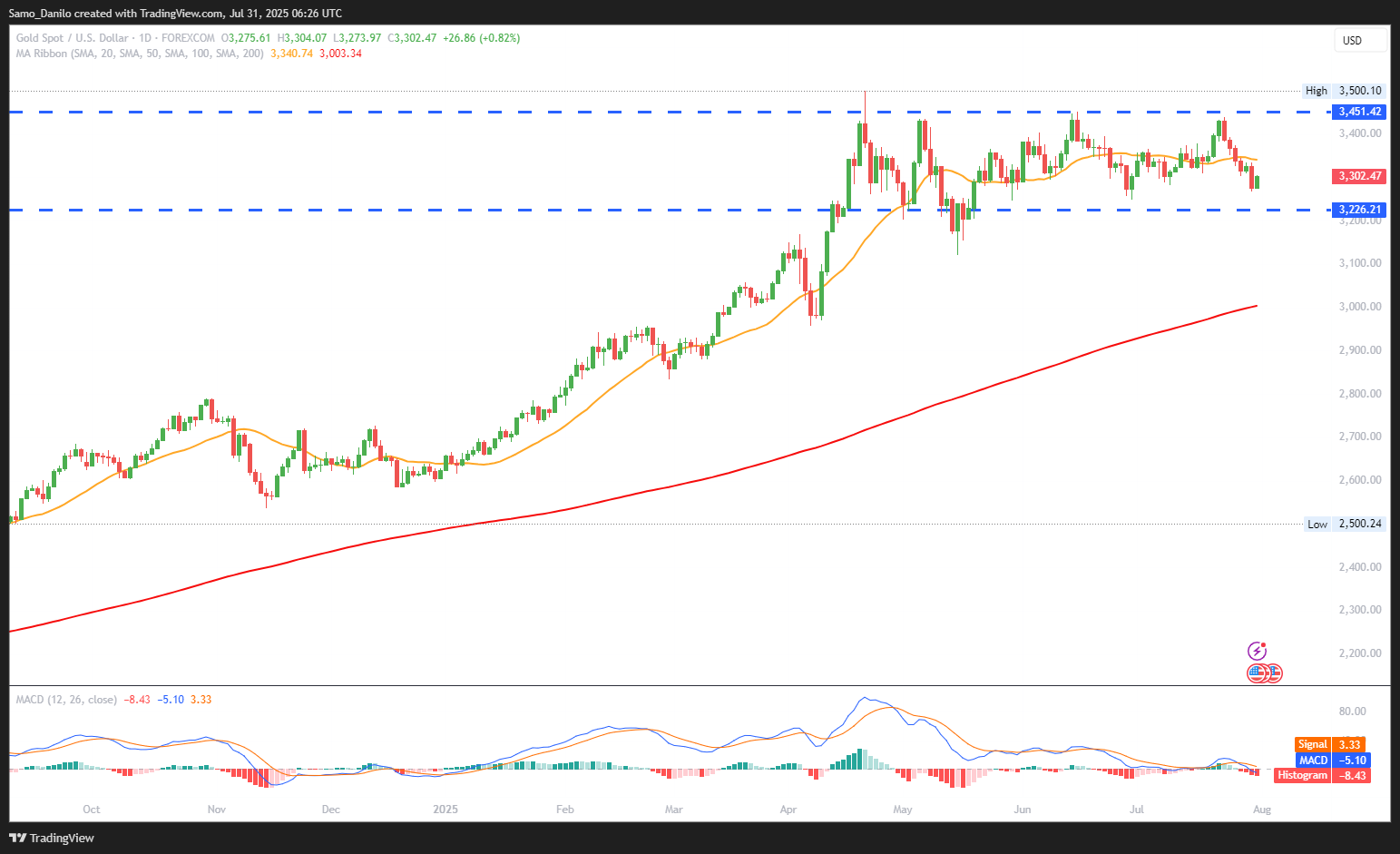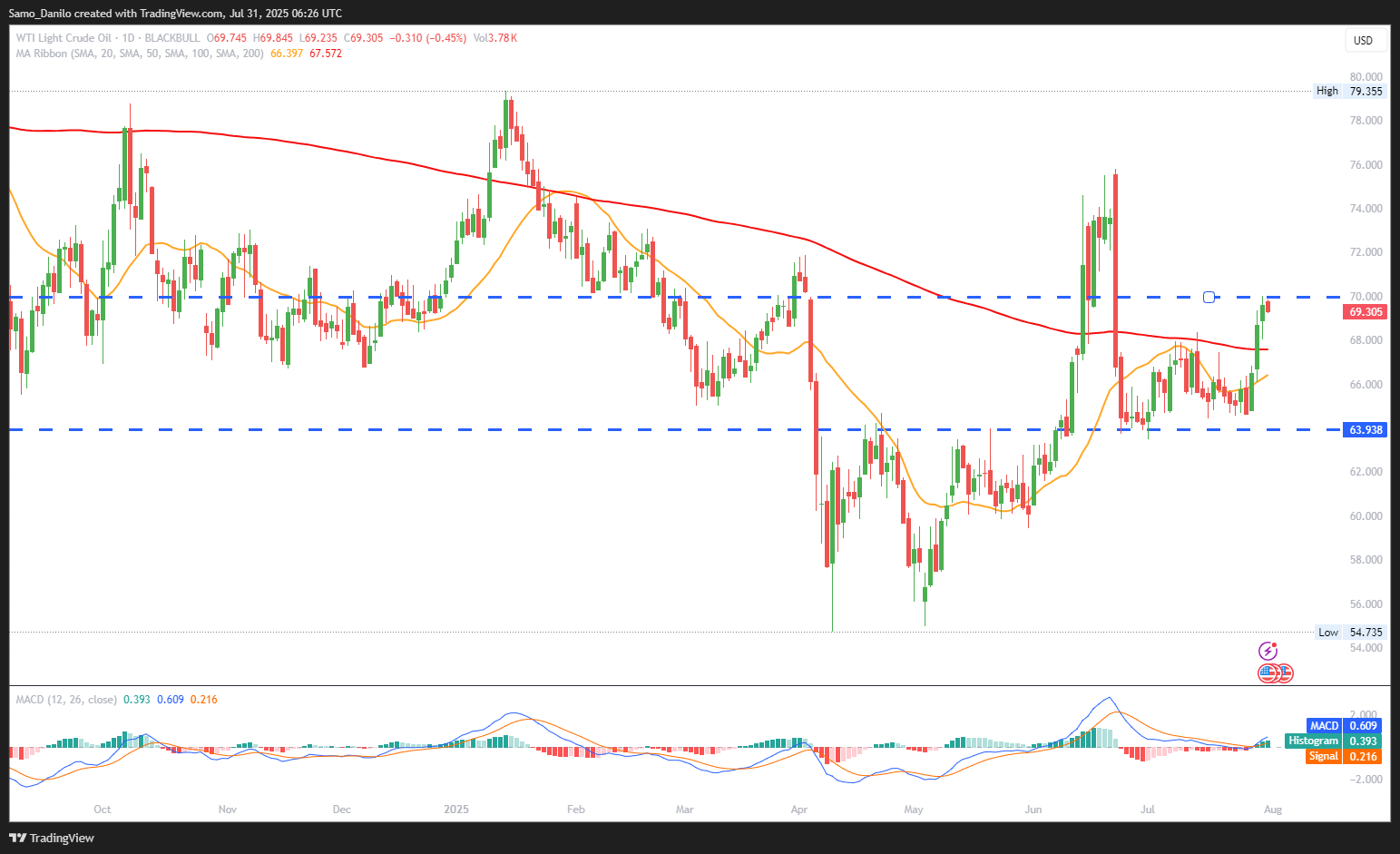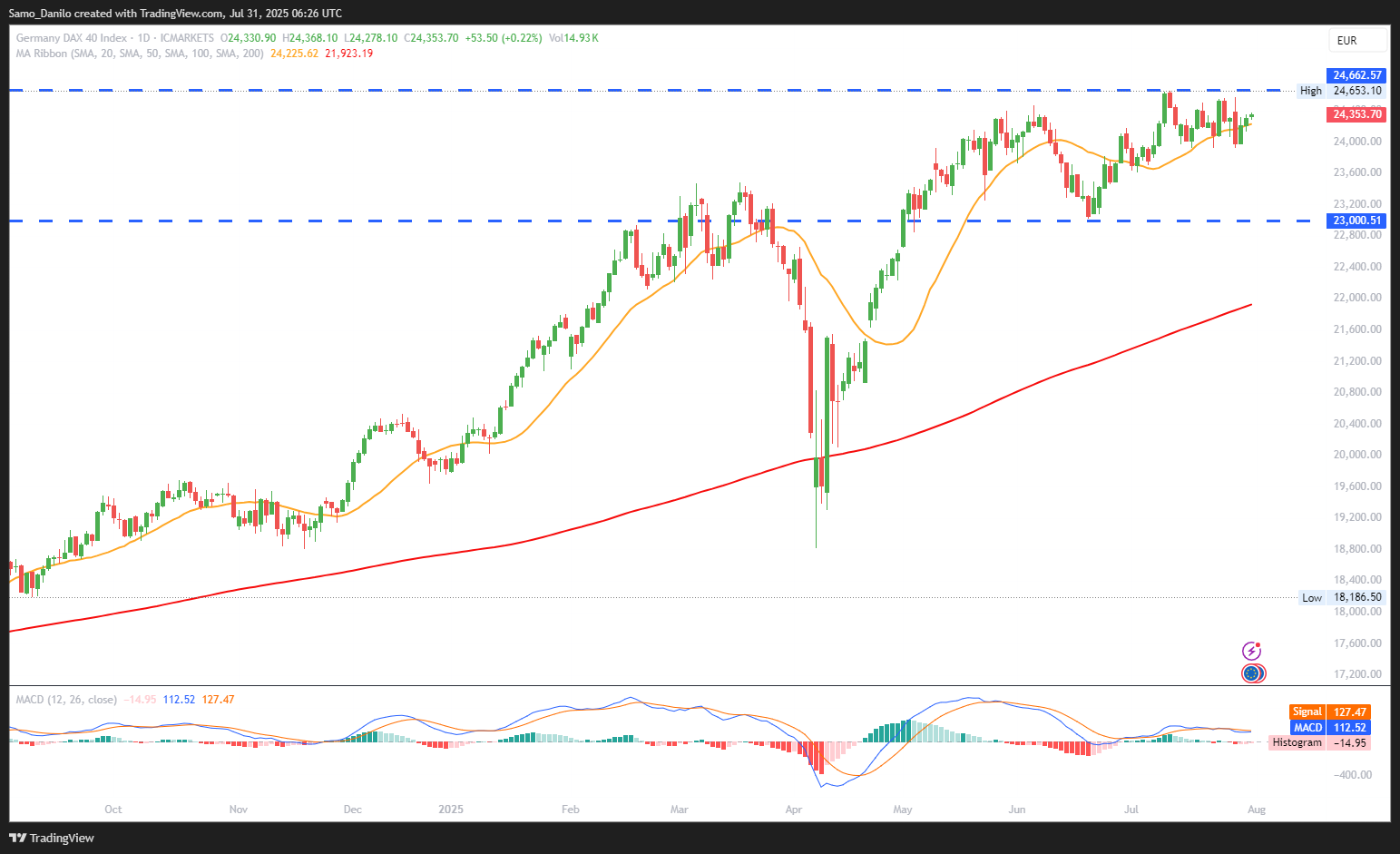EURUSD
- EUR/USD Price: The Euro remains under pressure, falling for a fifth consecutive session against the US Dollar, though a mild rebound occurred Wednesday. Persistent USD strength, driven by relative economic outperformance, continues to weigh on the pair.
- Eurozone GDP: Preliminary Q2 GDP rose 0.1% QoQ, slightly beating expectations. France and Spain led modest gains, while Germany and Italy lagged, highlighting ongoing asymmetries in the euro area recovery.
- Business Sentiment: The Economic Sentiment Indicator (ESI) rose to 95.8, a five-month high, reflecting gradual improvement in business confidence. However, the data failed to materially boost the euro, as economic momentum remains limited.
- Consumer Confidence: Final consumer confidence for July stood at -14.7, matching the preliminary figure. While still negative, the reading points to slight resilience, helped by optimism in the services sector heading into H2.
- PCE Inflation: The US PCE Price Index increased by 2.5% QoQ in Q2, above the 2.4% estimate but down sharply from the 3.5% prior. This supports the view of sticky but easing inflation, keeping the Fed cautious yet patient.
Closing statement: Despite slightly better Eurozone data, EUR/USD remains on the defensive due to ongoing USD strength and limited euro-area momentum. Unless the eurozone shows more robust and broad-based growth, the downward pressure is likely to persist.
GBPUSD
- GBP/USD Price: The GBP/USD pair recovered modestly during Thursday's European session, reversing part of Wednesday’s decline that saw it hit its lowest level since mid-May. This bounce, however, remains tentative amid broader bearish sentiment.
- BoE Rate Cut: The British Pound faces headwinds as markets increasingly price in a 25bps rate cut from the Bank of England on August 7. This dovish outlook continues to limit any meaningful upside for GBP in the near term.
- US GDP: The US economy grew 3.0% in Q2, significantly above the 2.4% consensus and marking a sharp turnaround from Q1’s 0.5% contraction. This robust data reinforces USD strength across major pairs, including GBP/USD.
- US Labor Market: The ADP Employment Report showed 104K new private sector jobs in July, easily beating expectations and reversing June’s weakness. This adds to signs of a resilient US labor market, further supporting the Greenback.
- Fed's Stance: Fed Chair Powell signaled no urgency for rate cuts, emphasizing a wait-and-see approach and expressing confidence in the US economy's strength. The hawkish tone contrasts sharply with the BoE's dovish tilt, amplifying pressure on GBP.
Closing statement: The GBP/USD recovery appears fragile, capped by dovish BoE expectations and strong US economic fundamentals. Unless UK data surprises to the upside, the bias remains tilted to the downside, especially if the Fed holds firm on rates.
XAUUSD
- XAU/USD Price: Gold prices extended their decline on Thursday, sliding toward the $3,300 level as traders digest robust US data and continued dollar strength. The yellow metal remains under pressure amid reduced safe-haven demand.
- Fed Rates: The FOMC voted 9-2 to maintain the federal funds rate at 4.25%-4.5%, with Fed Chair Powell resisting political pressure for rate cuts. The hawkish tone and internal dissent reinforce the view that policy easing is not imminent.
- China Focus: President Xi Jinping signaled renewed efforts to stimulate domestic consumption and reverse economic stagnation after the latest Politburo meeting. While lacking specifics, this policy pivot suggests potential demand-side support for gold longer term.
- Regulatory Changes: Starting Friday, China will tighten controls on large cash purchases of precious metals, requiring reporting of transactions exceeding 100,000 yuan. This may dampen short-term retail demand, especially in unregulated or informal channels.
- Market Sentiment: Despite global uncertainties, Gold is failing to regain traction, weighed by Fed policy, strong dollar performance, and shifting consumption trends.
Closing statement: Gold’s technical and fundamental outlook is weakening, as Fed resilience and regulatory tightening in China offset potential bullish drivers. Unless macro or geopolitical risks resurface, XAU/USD may remain vulnerable near-term.
CRUDE OIL
- Crude Oil Price: West Texas Intermediate (WTI) crude traded near $69.30 on Thursday during European hours, extending weakness after a bearish US inventory report and mixed global demand signals.
- US Crude Inventories: The EIA reported a 7.698 million barrel increase in US crude oil stockpiles for the week ending July 25, a sharp reversal from the prior week’s draw. The unexpected supply surge pressured prices, highlighting potential oversupply risks.
- Trump's Tariffs: President Trump announced a 25% tariff on Indian exports, effective Friday, and criticized India's energy ties with Russia. Markets fear this move could strain global trade and reduce access to Russian crude, possibly tightening global supply dynamics longer term.
- US-China Trade: China’s Commerce Ministry described recent talks with US business leaders as constructive, opposing economic decoupling and encouraging further foreign investment. This added a mildly supportive tone for oil, suggesting global trade ties remain partially intact.
- Chinese Manufacturing: China's official Manufacturing PMI fell to 49.3 in July, below expectations, signaling a continued contraction in factory activity. The sluggish industrial demand outlook from China, the world’s largest crude importer, dampens bullish sentiment for oil.
Closing statement: Crude oil prices are pressured by rising US inventories and weak Chinese manufacturing, but geopolitical risks involving India and Russia could tighten supplies in the medium term. For now, WTI remains range-bound with a bearish tilt, pending clearer demand signals.
DAX
- DAX Price: The DAX index recovered further on Thursday, reaching around 24,350, reversing early-week losses as sentiment improved ahead of key corporate earnings.
- German GDP: Germany’s preliminary Q2 GDP fell by 0.1% quarter-over-quarter, matching expectations. The persistent manufacturing recession continues to weigh on economic output, with weak external demand and structural pressures remaining key concerns.
- Import Prices: June Import Price Index came in flat (0.0%) month-over-month, slightly better than the expected decline. On a yearly basis, prices dropped 1.4%, mainly due to a 13.6% plunge in energy prices, signaling easing cost pressures on the industrial sector.
- Regional CPI: German states’ CPI figures for July are being published today, but are not expected to alter the European Central Bank’s current summer pause stance, with inflation broadly stabilizing across the Euro Area.
- Earnings Season: Quarterly reports from BMW and Heidelberg Materials, along with numerous results from MDAX and SDAX companies, are in focus today. Investors will closely watch corporate margins and forward guidance amid the tepid macro backdrop.
Closing statement: The DAX is regaining ground, but Germany’s weak GDP print and stagnant price data underscore lingering economic softness. Unless corporate earnings deliver upside surprises, gains may remain limited in the near term.
